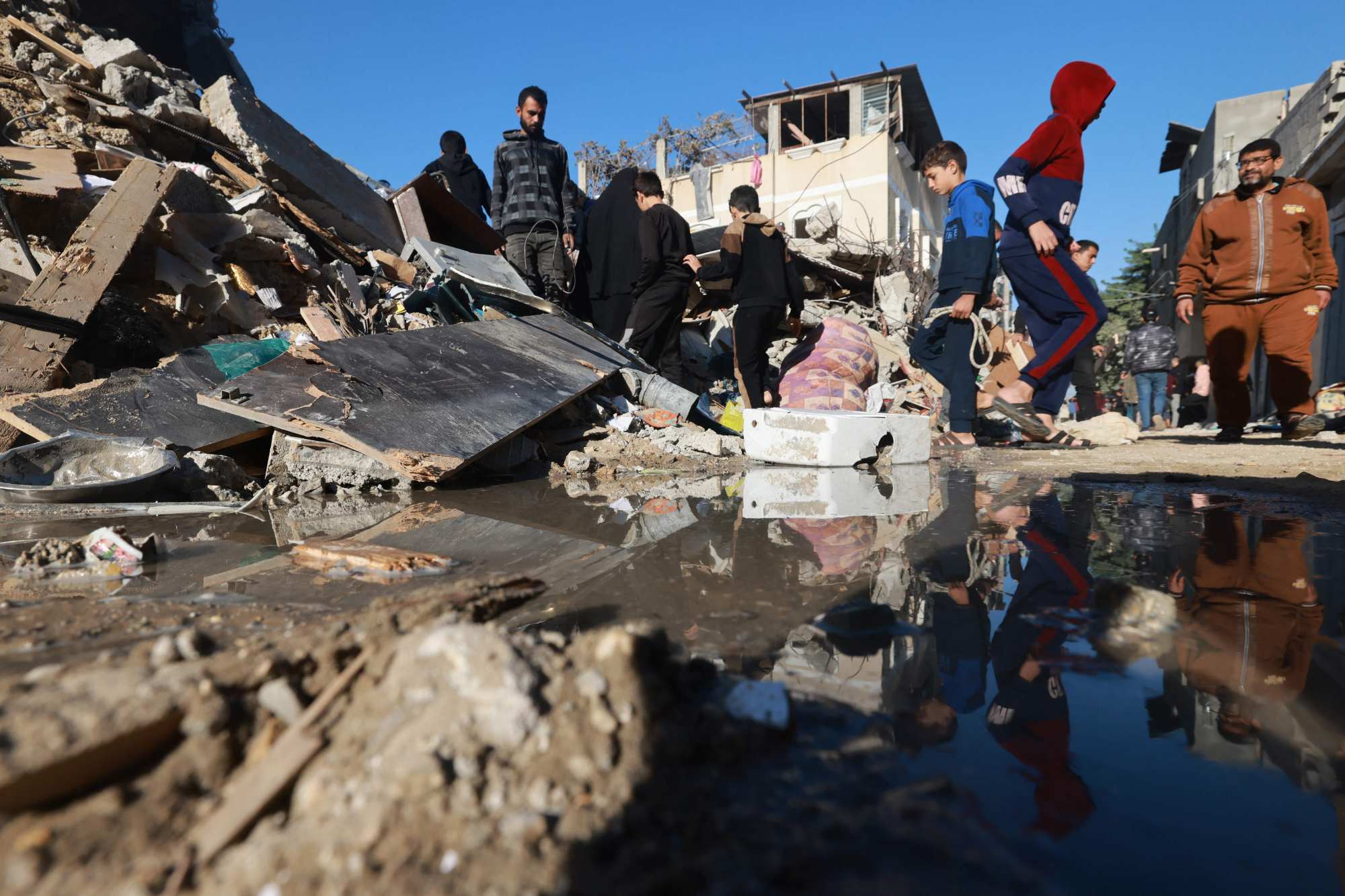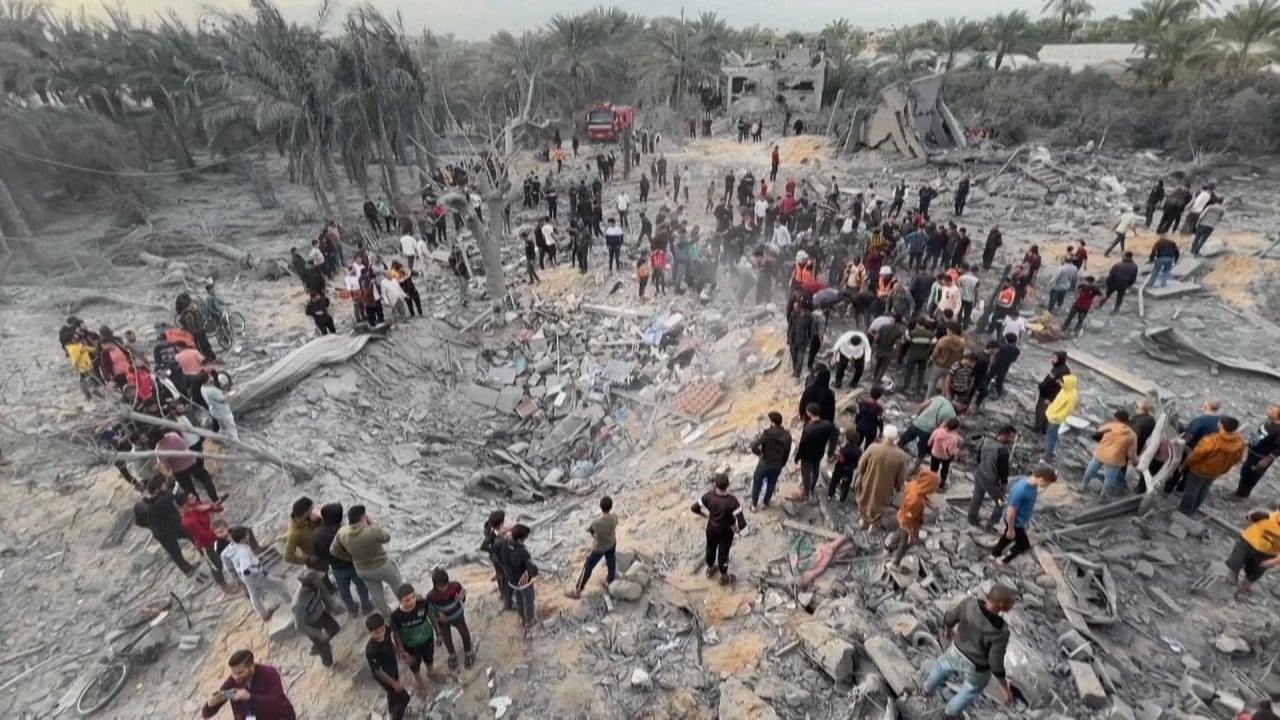On Sunday, a spokesman for the Israel Defence Forces (IDF) called in Arabic on residents to leave specified areas in the south of the Gaza Strip and to go to designated areas, as IDF aerial bombardments hit targets in both the north and the south following the end of the truce.
Israel’s military ordered more locations in and around Gaza’s second-largest city of Khan Younis to evacuate, as it shifted its offensive to the southern half of the territory where it says many Hamas leaders are hiding.
Heavy bombardments were reported overnight and into Sunday in the area of Khan Younis and the southern city of Rafah, as well as parts of the north that had been the focus of Israel’s blistering air and ground campaign.
Many of the territory’s 2.3 million people are crammed in the south after Israeli forces ordered civilians to leave the north in the early days of the 2-month-old war.
Activists decry silence over evidence of sexual violence in Hamas attacks
Activists decry silence over evidence of sexual violence in Hamas attacks
With the resumption of fighting, hopes receded that another temporary truce could be negotiated. A weeklong ceasefire, which expired Friday, had facilitated the release of dozens of Gaza-held Israeli and foreign hostages and Palestinians imprisoned by Israel.
“We will continue the war until we achieve all its goals, and it’s impossible to achieve those goals without the ground operation,” Prime Minister Benjamin Netanyahu said on Saturday night.
On Sunday, the Israeli military widened evacuation orders in and around Khan Younis, asking residents of at least five more areas and neighbourhoods to leave for their safety.
Residents said the Israeli military dropped leaflets ordering them to move south to Rafah or to a coastal area in the southwest. “Khan Younis city is a dangerous combat zone,” the leaflets read.
The main hospital in Khan Younis received at least three dead and dozens wounded Sunday morning from an Israeli strike that hit a residential building in the eastern part of the city, according to an Associated Press journalist at the hospital.
Separately, the bodies of 31 people who were killed in Israeli bombardment across the central areas of the strip were taken to the Al-Aqsa Martyrs hospital in Gaza’s central city of Deir al-Balah, said Omar al-Darawi, an administrative employee at that hospital.
Associated Press video showed bodies in white body bags on the ground outside the hospital in Deri al-Balah as dozens of people held funeral prayers on Sunday morning. The bodies were then taken on a truck for burial.
One woman wept, cradling the body of a child on her lap as she sat on a chair. Another adult carried the body of a baby as he got into a truck.
UN monitors said in a report issued before the latest evacuation orders that those who were told to leave make up about one-quarter of the territory of Gaza, home to nearly 800,000 people before the war.
The United States, Israel’s closest ally, has warned Israel to avoid significant new mass displacement.
The Israeli military said Sunday that its fighter jets and helicopters “struck terror targets in the Gaza Strip, including terror tunnel shafts, command centres and weapons storage facilities” overnight, while a drone killed five Hamas fighters.
Israel army says 5 Gaza hostages confirmed dead
Israel army says 5 Gaza hostages confirmed dead
In northern Gaza, rescue teams with little equipment scrambled Sunday to dig through the rubble of buildings in the Jabaliya refugee camp and other neighbourhoods in Gaza City in search for potential survivors and dead bodies.
“They strike everywhere,” said Amal Radwan, a woman sheltering in Jabaliya, an urban refugee camp. “There is the non-stop sound of explosions around us.”
Mohamed Abu Abed, who lives in the Sheikh Radwan neighbourhood in Gaza City, also said there were relentless air strikes and shelling.
“The situation here is imaginable,” he said. “Death is everywhere. One can die in a flash.”
The Health Ministry in Hamas-ruled Gaza said on Saturday that the overall death toll in the strip since the October 7 start of the war had surpassed 15,200, a sharp jump from the previous count of more than 13,300 on November 20.

The ministry does not differentiate between civilian and combatant deaths, but it said 70 per cent of the dead were women and children. It said more than 40,000 people had been wounded since the war began.
US appeals to protect civilians came after an offensive in the first weeks of the war devastated large areas of northern Gaza. Much of Gaza’s population is packed into the territory’s southern half.
The territory itself, bordering Israel and Egypt to the south, is sealed, leaving residents with the only option of moving around within Gaza to avoid the bombings.
“Too many innocent Palestinians have been killed. Frankly, the scale of civilian suffering and the images and videos coming from Gaza are devastating,” US Vice-President Kamala Harris told reporters on Saturday during the Cop28 climate conference in Dubai.
Mark Regev, a senior adviser to Netanyahu, said Israel was making “maximum effort” to protect civilians and the military has used leaflets, phone calls, and radio and TV broadcasts to urge Gazans to move from specific areas.
He added that Israel is considering creating a security buffer zone that would not allow Gazans direct access to the border fence on foot.
Harrowing stories emerge as Hamas frees more Gaza hostages
Harrowing stories emerge as Hamas frees more Gaza hostages
Israel says it targets Hamas operatives and blames civilian casualties on the militants, accusing them of operating in residential neighbourhoods.
It claims to have killed thousands of militants, without providing evidence, and says at least 78 of its soldiers have been killed in the offensive in northern Gaza.
Bombardments on Saturday destroyed a block of about 50 residential buildings in the Shijaiyah neighbourhood of Gaza City and a six-storey building in the urban refugee camp of Jabaliya on the northern edge of the city, said the UN Office for the Coordination of Humanitarian Affairs.
More than 60 people were killed in the Shijaiyah strikes and more than 300 buried under the rubble, the monitors said, citing the Palestinian Red Crescent.
Mahmoud Bassal, a spokesman for Gaza’s Civil Defence, said rescuers lack bulldozers and other equipment to reach those buried under the rubble, confirming the Red Crescent estimate of about 300 people missing. He said the block had housed over 1,000 people.
“Retrieving the martyrs is extremely difficult,” he said in video comments from the site of the attack.
The war was sparked by an October 7 attack by Hamas and other militants that killed about 1,200 people, mostly civilians, in southern Israel. Around 240 people were taken captive.
The renewed hostilities have heightened concerns for over 130 hostages, who the Israeli military says are still being held after 105 were freed during the recent truce. Israel freed 240 Palestinians.
Most of those released on both sides were women and children.
Additional reporting by dpa


